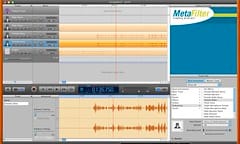How to record a kickass podcast between two macs -- and cheap!
I've updated this with a lot more info over on my Fortuitous Blog: Everything I've learned about Podcasting
A lot of people ask me how I do the MetaFilter Podcast (warning: the podcast makes no sense to anyone outside of MetaFilter uberfans). I know they don't mean "how do you do it man, you're making magic over there every week!" but rather "what software and hardware does it take to make a decent sounding podcast?" After almost a year of regular podcasts and trying out different software and equipment, I've gotten the workflow down cold and I wanted to share the my way of making a good sounding podcast on the cheap. This works perfectly well for me being in Oregon and talking to my friend Jessamyn in Vermont over Skype, recording at both ends, then tossing it all into Garageband to complete the podcast. I read a lot of podcast how-tos when I set out to do my own, and almost all of them are mired in technical details about microphone quality and USB vs. mixer board audio wankery. Most every tutorial about doing a podcast interview focuses way too much on studio-like sound quality achieved through your equipment instead of through software and a bit of clever thinking. So without further ado: How to record a good podcast between two mac users on the cheap Software required:
- Skype (free)
- Call Recorder for Skype ($15/each or 3 for $30, plus free 30 day demo)
- Garageband (included with most Macs, or $79 for iLife)
Hardware required:
- Logitech USB headset microphone ($35 from Amazon)
Though you might have heard bad phone interview podcasts with Skype before, having Call Recorder running on both sides of your interview will mean your interview partner will have a crystal clear recording just like yours. The cheap headset microphones are brain-dead simple to use on a Mac (plug-in, change audio prefs to use the headset for input and output, adjust the recording level) and produce perfectly good vocal recordings. I've used $250 higher-end microphones and had little audio quality improvement. This process assumes two people, each running Skype, Call Recorder, and having a USB headset microphone. The Interview Recording:
- Start a Skype chat between you and your partner
- Both parties hit the record button on their Call Recorder (I record on high quality, low compression AAC)
- Conduct your interview normally
- When interview is complete, end call, stop recording
- Call Recorder includes a directory of mini-apps called Movie Tools. Have your partner locate their recording file and tell them to drag it over the "Split Movie Tracks" application
- Have partner upload Track 1 of the split movie files to a server you can download the file from
Assembling the podcast in Garageband:
- Drag your copy of the interview recording over Split Movie Tracks to turn your recording into one file for each side of the Skype conversation
- Drag each resulting .mov file over another Movie Tools app "Convert to AIFF"
- Drag your partner's half interview (that you downloaded from them) .mov file over Convert to AIFF
- Open Garageband, start a new podcast
- Duplicate one of the vocal tracks (my partner is female so I duplicate the default female track
- Drag your own Track 1 AIFF track into a Garageband track (my goes into the default Male Voice)
- Drag your own Track 2 AIFF track into Garageband, perfectly aligned with our Track 1 (this ensures the timings are exact for each side of your own interview recording)
- Drag your partner's Track 1 AIFF track into the duplicated track in Garageband
- Garageband quickly analyzes each track and makes visual soundwaves to go with each track. "Line up" your Track 2 and your partner's Track 1 audio files. The peaks and flat quiet area should look really similar (click screenshot below, view notes on the image itself)

- Once your partner's vocal track is lined up (press play to hear all three tracks and your partner should sound like an almost perfect echo from their two tracks), delete your own Track 2 track. You now have two high quality recordings from each respective source, ready for continued editing into your podcast (you can level out the volume if one person was louder, clip out pauses and coughs together, etc)
How does it sound? To give you an idea of how it sounds, consider the following three sample recordings. The first is the worst possible: recorded Skype conversation where I dialed out to a phone and recorded the entire thing on my end (mp3 sample 1 96kbps) Second, here is what a standard recorded Skype call sounds like, where I recorded both sides of the conversation on my end, so my partner was recorded through Skype and even on my high bandwidth fiber connection, it does have artifacts (mp3 sample 2 96kbps) Third, here is the same interview segment as the second part, but with my partner's local recording track thrown in and my recording of her track thrown out. Much better and to me, sounds like we could be in the same room, even though we are 3,000 miles apart. (mp3 sample 3 128kbps) Conclusion The basic premise of this approach is you can record a Skype interview without actually needing/using Skype. You are actually recording audio on each end independent of Skype, so you won't suffer any sound quality problems due to Skype transport. So that's it, for about $100 or so, you can have a pretty damn good podcast that sounds like two people sat in a room together talking and recording, even if they're on opposite sides of a country.
Subscribe to our newsletter.
Be the first to know - subscribe today





